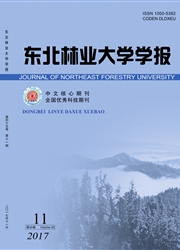

 中文摘要:
中文摘要:
提出了一种基于木材表面光谱反射率的新型木材树种分类识别系统,它解决了下面三个问题。首先,考虑到实际采集的光谱反射率曲线在某些波长噪声较大,这些波长应该被删除。另外,木材光谱反射率曲线波段为350~2 500 nm,原始实验数据为一个2 150维的向量(光谱采样间隔设定为1 nm),所以要对光谱数据进行特征选择和降维处理。为高效和同时地解决这两个问题,使用了一种散步矩阵求解特征值方法进行了光谱特征波长的特征选择,同时还对噪声波长进行了滤波处理。该方法收到了较好的效果,具有一定的新颖性。最后,为了使光谱仪采集到的光谱反射率曲线具有最佳的模式可分性信息,还对室内照明光源的安装高度进行了最优化设计,使用遗传算法求解出光源的最佳安装高度,使得采集的光谱反射率曲线具有最佳的树种分类信息。因此,提出的这种照明光源安装高度优化设计方法,在一定程度上提高了树种分类识别的精度,它具有较好的可行性和一定的新颖性。针对东北地区常见的五种树种(白松、樟子松、落叶松、杨木和桦木)木材进行大量的(约10万次)分类测试,实验结果表明五种树种木材的混合识别率达到了95%以上,具有较好的分类识别精度和速度。特征选择的波长主要集中在近红外波段。
 英文摘要:
英文摘要:
This paper proposes a novel wood species recognition scheme based on the spectral reflection features of wood surface,aiming to address the following three issues in terms of the noise filtering,feature selection and radian's optimal design.First,noises occur in some bands of wood spectral reflection curve so that these noisy bands should be deleted.Second,the wood spectral band is 350~2 500 nm,which is a 2 150 D vector with a spectral sampling interval of 1 nm.Therefore,both noise filtering and feature selection should be performed to wood spectral data.In this paper,to simultaneously and efficiently solve the two problems of feature selection and noise filtering,both a feature selection procedure and a noise filtering procedure are performed by solving the eigenvalues of dispersion matrix.This scheme is novel and produces a good outcome.Third,to make the spectral reflection curves picked up by the spectral instrument have the best pattern recognition information;an optimal design is performed for the indoor radian's mounting height.The genetic algorithm is used to solve the optimal radian's height so that the spectral reflection curves have the best classification information for wood species.Therefore,the optimal design scheme for the radian's mounting height can improve the pattern classification accuracy of the wood species to some extents,which is novel with excellent executive feasibility.Many experiments made with our developed software system on the five ordinary wood species in northeast region of China(i.e.,including Betula platyphylla,Populus davidiana,Pinus Sylvestris,Picea jezoensis,Larix gmelinii) are performed for approximately 10 s times.It indicates that the overall recognition rate reaches to a good recognition accuracy of 95%for five wood species with an ideal recognition velocity.The selected feature wavelengths by using of our feature selection algorithm based on dispersion matrix are mainly in the near infrared band.
 同期刊论文项目
同期刊论文项目
 同项目期刊论文
同项目期刊论文
 期刊信息
期刊信息
